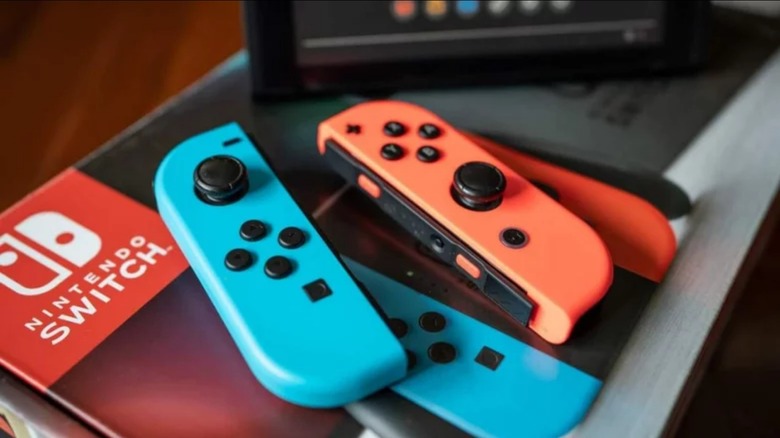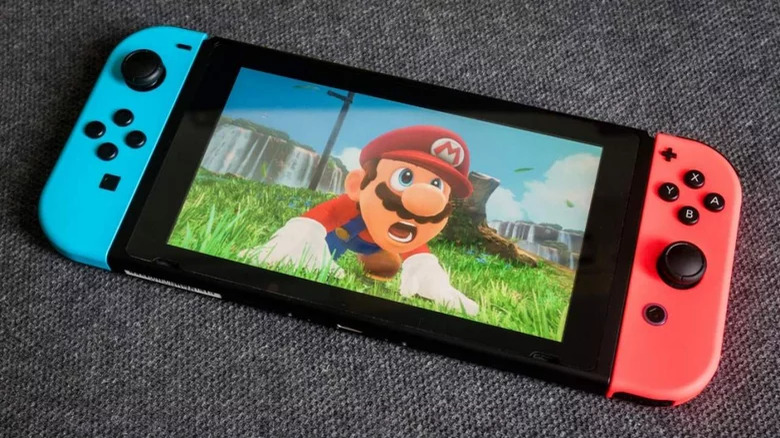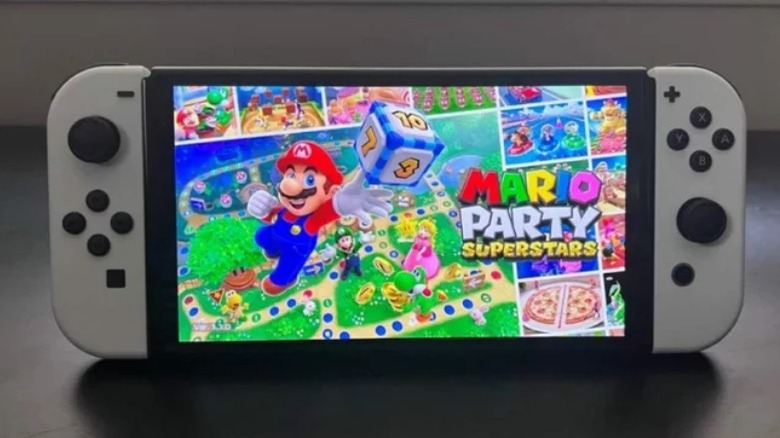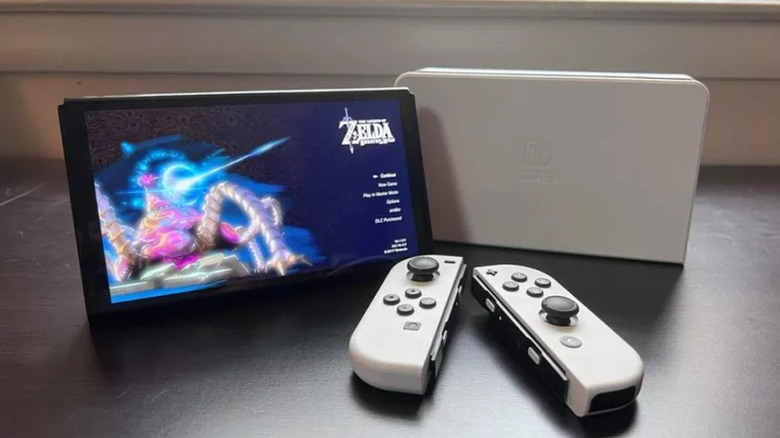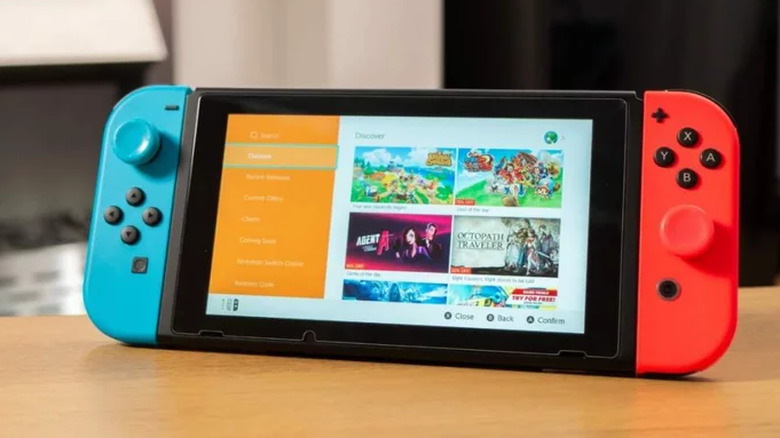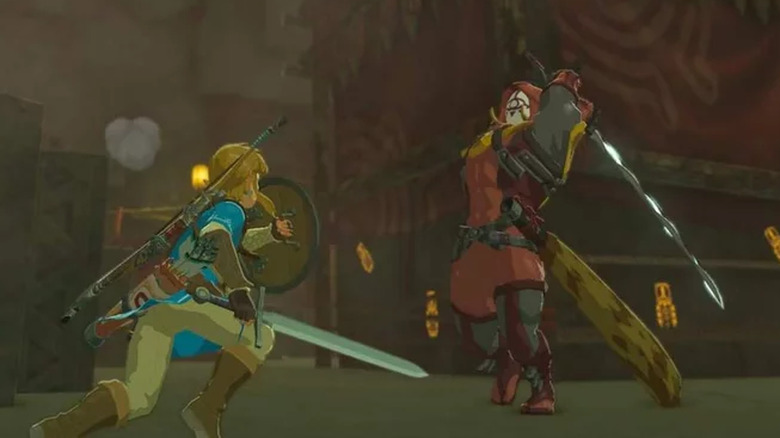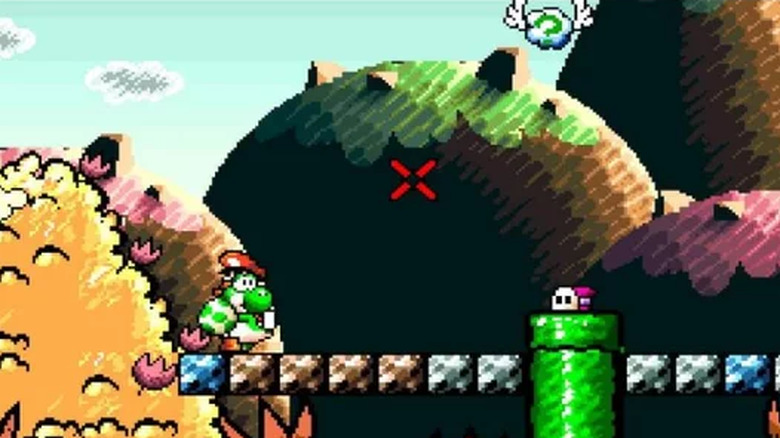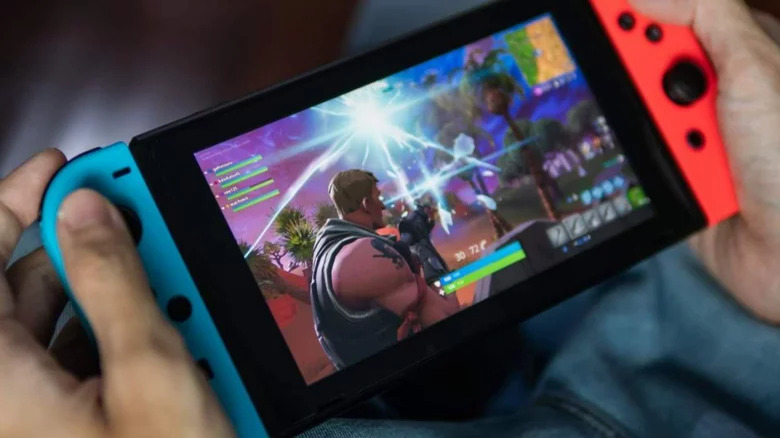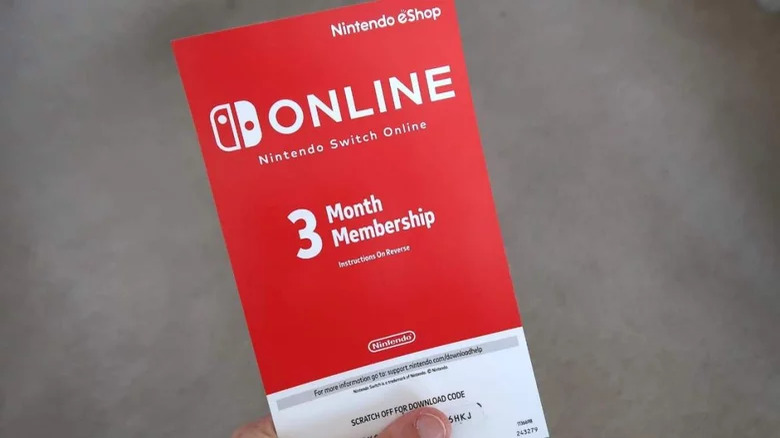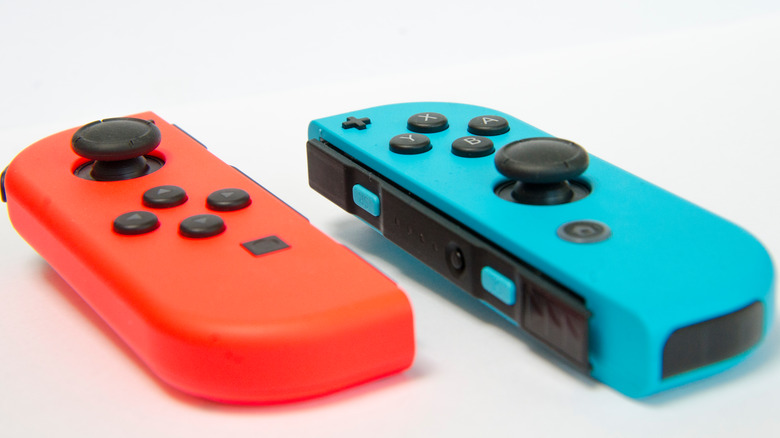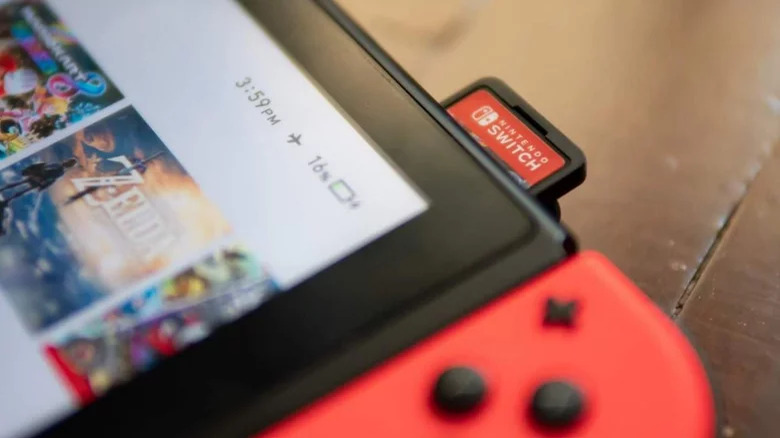10 Features We Want To See In Nintendo Switch 2
Nearly five years on, it's safe to say the Nintendo Switch is a success. According to Nintendo sales data, the Switch has come dangerously close to selling 100 million units worldwide, with almost 700 million software units sold to boot. Not only will the Switch soon take its place in the 100-million-sellers club — a club few home consoles have joined — but it has the potential to become one of the best-selling game platforms of all time.
Nintendo took a big gamble with the Switch's design, which allows for handheld and TV usage modes through a built-in display, detachable controllers, and an accompanying HDMI dock. The design has turned out to be such a hit that it's now hard to imagine Nintendo abandoning this hybrid approach with subsequent consoles. While we have no idea what the future will hold, here are 10 features we'd like to see in a Nintendo Switch 2 — assuming, of course, that there ever is one.
A higher-resolution display
This is an obvious choice to start our list of most-wanted Nintendo Switch 2 features. Regardless of the Switch model you buy, whether it's the standard Switch, Switch Lite, or Switch OLED, it's going to come with a 720-pixel display. At the screen sizes we're talking about here (a max of seven inches on the Switch OLED and smaller than that for the other two models), 720p isn't an awful resolution, but it's not great either. It was the bare minimum that was acceptable for the Switch in 2017, so it would be a shame to see a similarly-specced display on the Switch's successor.
It would be nice to see the Switch 2 outfitted with a 1080p display, though that might chew through battery life faster than Nintendo wants. Even something like 900p would be a big improvement over 720p. That could serve as something of a middle ground, too, providing sharper visuals than 720p while not eating through battery life as quickly as a 1080p display would. At the end of the day, we're not picky, just give us something more than a 720p display with the next Switch.
But keep the OLED panel
The Switch OLED launched in October of 2021, and even though it wasn't what we were expecting, it's still a good console. The biggest upgrade is unquestionably the OLED display that adorns the console, which is a big step up from the LCD panel on the original Switch. Colors are more vibrant and the display itself is bigger, making for a superior handheld experience compared to the original Switch.
There's just one problem: Despite the nicer display, there isn't much reason for current Switch owners to upgrade to the Switch OLED. With nearly 100 million Switches sold so far (via Nintendo Life), that means there are a lot of people out there who are going to miss out on the OLED display.
We've argued before that Nintendo should just discontinue the standard Switch and make the Switch OLED the new mainline model, but barring that, Nintendo should make the OLED display standard on the Switch's successor. There's nothing wrong with a solid LCD display, but once you start playing on the Switch OLED, it's hard to go back. It would be great to see it as the default option on the next Switch.
A more portable dock
As it is, the Switch dock is a perfectly serviceable accessory that's a little boring and not the easiest thing to transport. While the total footprint of the Switch, its dock, and cabling is a far cry from other consoles (including the PS5 and Xbox Series X, two current-gen behemoths), it would be nicer to see a dock that's easier to transport with a potential Nintendo Switch 2.
While bringing the dock with you might defeat the purpose of the Switch's portability, that portability is only a factor if you're playing alone. Tabletop mode is not a good solution for multiplayer gaming, especially when all you need is an outlet and an HDMI cable to make the dock work.
A number of third-party manufacturers have already made portable docks for the Nintendo Switch, so it would be nice to see Nintendo go that route with the Switch 2 as well. If nothing else, Nintendo could offer smaller, more portable travel docks alongside the standard full-sized dock to give users more options when hitting the road.
A better eShop
A portable platform like the Switch is practically made for digital games. The problem is that the Switch eShop is a dreadful place to visit. It's slow, unresponsive, and just a pain in general to navigate. Back in the early days, the Switch eShop was okay, but with so many games available on the platform, it quickly became a nightmare to use.
With a new Switch comes a chance for Nintendo to fix the issues with the Switch eShop. I'm not sure what an improved version of the eShop would look like, but it wouldn't be hard to make something better than what we've got.
As it stands, it's advisable to never visit the eShop on the Switch itself. It's far better to get on a computer and visit the eShop website to do your searching and buying. On a platform that's all about being flexible and portable, that isn't a good look. In a Switch successor, an optimized eShop is simply a must-have.
User reviews for games
While we're on the topic of the eShop, why not allow user ratings for games? With the loads of shovelware a popular platform like the Switch attracts, users need some way of telling good from bad, but with the Switch eShop as it currently exists, that's impossible. Years ago, Nintendo even launched user reviews on the eShop, but then quickly took them down.
Even though the company said feedback about user reviews was positive, we haven't heard more on the feature since. It would be great if future iterations of the eShop had some kind of user review functionality baked in from the start — one that doesn't disappear later when Nintendo gets cold feet.
Sadly, since we haven't heard anything about user reviews returning to the Switch after several years, it seems unlikely that Nintendo is going to revisit this feature in the future. That's a shame because as much as users reviews get criticized for being susceptible to mob mentality and review bombing, they can still be very useful. For more mainstream, out-of-the-loop users who don't hit up Metacritic or OpenCritic before buying a game, they can be helpful when it comes to separating the good from the bad, so we'd like to see user reviews as a day-one feature on the Nintendo Switch 2.
A proper Virtual Console
If there's a pie-in-the-sky prediction on this list, it's probably this one, because at this point the Virtual Console is almost certainly dead and buried. Still, a fan can dream, and given the current state of retro gaming on the Switch, getting the Virtual Console back would indeed be a dream.
For the unfamiliar, the Virtual Console was available on the Wii, Wii U, Nintendo DS, and 3DS. It offered retro games from a variety of old platforms, and it was an excellent way to revisit classic titles. When the Switch arrived, the Virtual Console was nowhere to be seen, and now we know why: Nintendo wanted to use retro games to drive Nintendo Switch Online (NSO) subscriptions.
While the NES and SNES libraries available through NSO are good, they aren't as extensive as what was offered through the Virtual Console back in the day, and the N64 and Genesis libraries that are available through the Nintendo Switch Online Expansion Pack aren't worth the extra money. It would be great if the Virtual Console made a comeback on Nintendo Switch 2 and offered fans a chance to buy retro games on an individual basis, but now that Nintendo has started offering retro games as part of a subscription, it seems foolish to expect it to stop in the future.
Improvements to Switch Online connectivity
If you've ever ventured online in your Switch games, chances are you're familiar with the mess Switch Online can be. I can't think of a single game where lag wasn't present to some degree, and while online play will always have its hiccups, it's too frequent with Nintendo Switch Online.
These connectivity issues for Switch Online are probably down to the fact that most Switch consoles out there are relying on WiFi connections since the standard dock doesn't come with an integrated LAN port. Users with that dock under their TV can buy a USB wireless adapter, and the redesigned dock for the Switch OLED does come with a built-in LAN port, but there are still millions of Switches out there relying on shoddy WiFi connections for online play.
As we've noted in multiple game reviews (Super Mario Maker 2 and Super Smash Bros. Ultimate, specifically), Nintendo doesn't seem to care enough to do more than the bare minimum when it comes to implementing online functionality. That makes matters even worse, as we're left with online matches that frequently fall victim to lag.
Perhaps in something like Mario Party Superstars, this is okay, but in Super Smash Bros. Ultimate or Splatoon, it can quickly suck the fun out of playing online. If the company is going to charge us for the privilege of playing online, the least it can do is actually ensure online games are playable to begin with.
Drop the mobile app and go with integrated voice chat
If it feels like we're harping a lot on Nintendo Switch Online, it's because we are. The service is lackluster in most regards, but one area where it moves beyond mere mediocrity and into the realm of frustration is with the Nintendo Switch Online mobile app. Should Nintendo release a successor to the Nintendo Switch, that mobile app should be nowhere in sight.
The mobile app, for those who haven't used it, is used for voice chatting over Nintendo Switch Online. There is no support for voice chat baked into the Switch itself, with Nintendo instead directing people to the app. Some third-parties like Vivox have tried their hand at implementing voice chat on the Nintendo Switch, but Nintendo's first-party solution involves using that clunky, inconvenient mobile app.
Some speculate that Nintendo implements these half-baked online systems because it wants to protect children from abuse, while others will say stuff like the Switch Online mobile app is evidence of the company being behind the times when it comes to online functionality. Whatever the reason, Nintendo should make a decision in the next generation. Either give us fully-featured online services like voice chat or don't. Just don't implement measures that only go part way and then charge us for the chance to use these underdeveloped features.
Better Joy-Cons (pretty please)
It isn't exactly a secret that the Joy-Cons for the current Switch are not great. Not only are there an alarming number of reports claiming thumbstick drift, but they aren't exactly comfortable either. While they're good enough when using the console in handheld mode, they could be significantly improved in the Nintendo Switch 2.
The biggest improvement would be the most obvious one: fix thumbstick drift. While the issue probably won't be sorted out entirely in a follow-up — controllers beyond the Switch Joy-Cons are susceptible to drift as well, after all — it sure seems like there's room there to make them much better.
Beyond better tempering the thumbsticks against drift, it would be nice to see Joy-Cons which adopt a more ergonomic design, too. The current Joy-Cons are small and mostly flat, which doesn't make them very comfortable to use for long periods of time. It would be great to see Nintendo give Joy-Cons a more ergonomic design just so we're not driven to reach for the Pro Controller every time we'll be playing for an extended period.
Full Switch backward compatibility
Like the higher-resolution display, this one feels like another no-brainer for the Switch 2, but we're putting it on here just because of how critical it is. Whatever succeeds the Switch should be able to run Switch games, especially if that platform is positioned as a true successor to the Switch.
Thankfully, Nintendo is usually pretty good about this, as SlashGear has noted before. The Wii ran GameCube games, the DS ran GBA games, the 3DS ran DS games, and the Wii U ran Wii games. Nintendo has set the expectation of backward compatibility over the last couple of generations, so it seems safe to assume that whatever succeeds the Switch will play Switch games.
Obviously, there's no rule Nintendo has to follow just because it's set the expectation for backward compatibility, but with it becoming a major focus for Microsoft and even Sony with the PlayStation 5, fans will be expecting it in the Nintendo Switch 2. We'll keep our fingers crossed, but we're guessing this is a decision that's already been made over at Nintendo HQ.
The Nintendo Switch is a great console, but greatness can be improved. Let's hope that Nintendo, which has often kept its users at arm's length, listens to the feedback coming from fans about things like Joy-Con drift and Nintendo Switch Online. If it does, the Nintendo Switch 2 could very well turn out to be an amazing platform.
